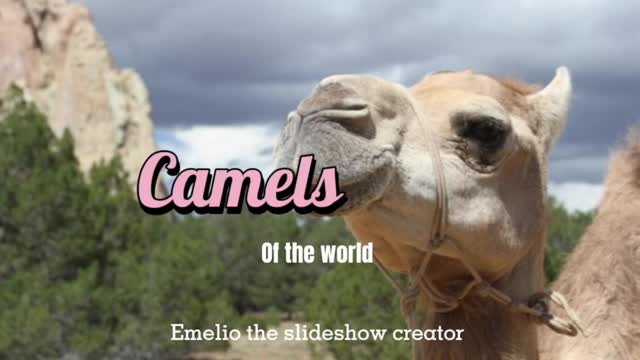Premium Only Content

Video tribute to all Camels 🐪 in the world. Nature at its best.
Video tribute to all Camels 🐪 in the world. Nature at its best.
How do camels adapt to the desert environment?
#camels #camelshortsvideo #animals #nature #desert #shorts #youtubechannel #subscribe #twitch #like #instagram #share #contentcreator #Bactriancamel #camelsvideo #africa #saudiarabia #Arabia #mongoloancamel #kids #kidsvideo #kidsanimalsvideos #iraq #iran #middleeast #rumble #youtuber #youtube #instagram #twitter #facebook #wikipedia #biography
Camels 🐪 Wikipedia
A camel (from: Latin: camelus and Greek: κάμηλος (kamēlos) from Hebrew or Phoenician: גָמָל gāmāl.[7][8]) is an even-toed ungulate in the genus Camelus that bears distinctive fatty deposits known as "humps" on its back. Camels have long been domesticated and, as livestock, they provide food (milk and meat) and textiles (fiber and felt from hair). Camels are working animals especially suited to their desert habitat and are a vital means of transport for passengers and cargo. There are three surviving species of camel. The one-humped dromedary makes up 94% of the world's camel population, and the two-humped Bactrian camel makes up 6%. The Wild Bactrian camel is a separate species and is now critically endangered.
The word camel is also used informally in a wider sense, where the more correct term is "camelid", to include all seven species of the family Camelidae: the true camels (the above three species), along with the "New World" camelids: the llama, the alpaca, the guanaco, and the vicuña, which belong to the separate tribe Lamini.[9] Camelids originated in North America during the Eocene, with the ancestor of modern camels, Paracamelus, migrating across the Bering land bridge into Asia during the late Miocene, around 6 million years ago.
-
 15:24
15:24
Tactical Advisor
17 hours agoBest 2011 of 2025 | Bul Armory Ultralight Pro
13.7K -
 27:31
27:31
True Crime | Unsolved Cases | Mysterious Stories
2 days ago $0.09 earnedThe Hong Kong Schoolgirl Mystery – 5 Mysterious Unsolved Cases (Part 8)
11.8K1 -
 7:19
7:19
China Uncensored
1 day agoChina is DONE in the South China Sea
10.8K17 -
 LIVE
LIVE
Joe Donuts Live
4 hours ago🟢 Loot Rats Unleashed: Arena Breakout Chaos! | Joe + Tony + Vlad
258 watching -
 30:37
30:37
Degenerate Plays
16 hours ago $0.01 earnedThis College Is Out Of Control - GTA Online : Part 9
7.19K -
 16:28
16:28
Mrgunsngear
3 days ago $0.49 earnedBeretta 92XI SAO Sabbia Review - A Few Surprises
9.36K6 -
 1:48
1:48
Memology 101
2 days ago $0.04 earnedThis aged like milk for Tish James...
4.69K7 -
 2:45:02
2:45:02
Boxin
4 hours agoGrounded! part 5
13.2K -
 43:37
43:37
American Thought Leaders
18 hours agoAfter 9 Years of Investigation, Here’s What I Uncovered | John Solomon
6.13K7 -
 1:02:27
1:02:27
The Heidi St. John Podcast
2 days agoWhen Government Becomes God with Bill Jack
1.45K